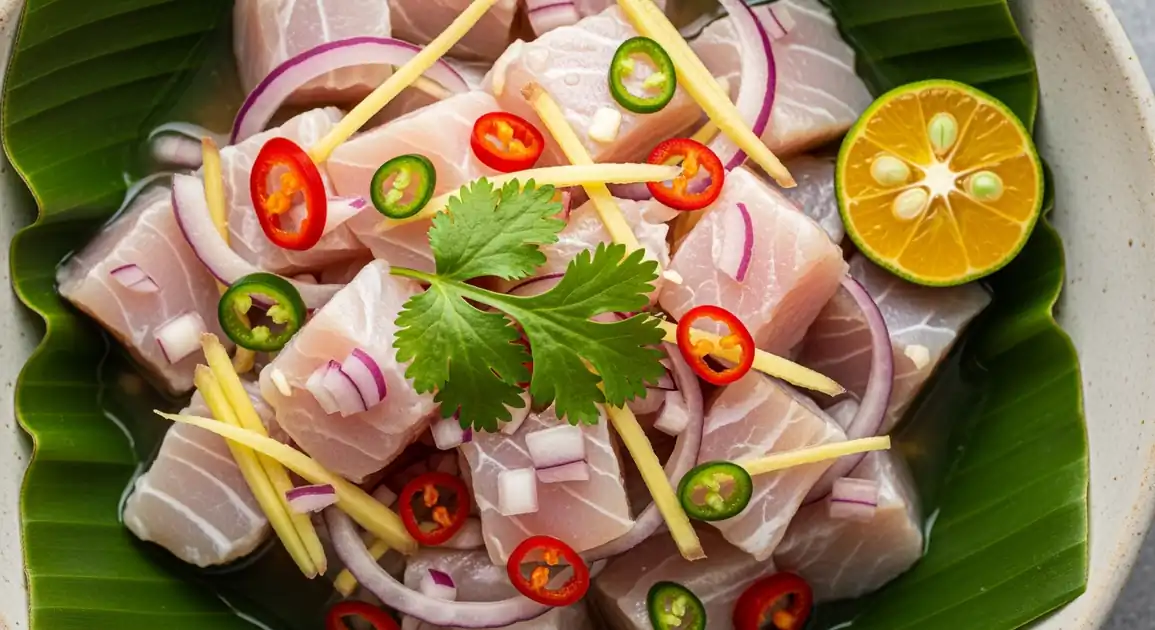Kinilaw (Filipino Ceviche)
Kinilaw

Description
Bohol, a scenic island province, offers distinctive kinilaw featuring locally-caught reef fish and coconut milk ('gata'). Boholano kinilaw often has a creamier, slightly sweeter profile than versions found elsewhere, reflecting the island's abundant coconut cultivation and diverse marine ecosystem.
Dietary Information
Serving information
Serving style
Often served in coconut shells or small wooden boats in tourist areas. Local eateries typically use simple ceramic bowls. Almost always garnished with local herbs and sometimes accompanied by a side of rice.
Quick facts
Markets: 6 AM - 1 PM. Beach restaurants: 11 AM - 10 PM. Tourist area venues: 10 AM - 11 PM.
Safety Tips
What to Look For
-
Very fresh fish with clear eyes and firm flesh
The fish should smell clean and oceanic, never fishy. For whole fish, look for clear (not cloudy) eyes, bright red gills, and firm flesh that springs back when pressed.
-
Preparation to order or very recently prepared
Kinilaw should be made fresh. The longer it sits in acid, the more the texture deteriorates. Ask when it was prepared.
-
Proper refrigeration of raw ingredients
Fish should be kept on ice or in refrigeration until preparation, especially in hot weather.
-
Sufficient acid in the mixture
The marinade should contain enough vinegar and citrus juice to properly denature the fish proteins. It should taste noticeably tangy.
-
Clean preparation area
Surfaces, knives, and containers should be clean to prevent cross-contamination.
What to avoid
-
Pre-made kinilaw sitting at room temperature
Kinilaw shouldn't sit for hours, especially unrefrigerated. This increases risk of bacterial growth.
-
Fish with a strong fishy smell or dull appearance
This indicates the fish isn't fresh. Fresh fish has minimal odor and appears vibrant.
-
Cloudy or slimy marinade
The liquid should be relatively clear to slightly milky (if coconut milk is added), never slimy or excessively cloudy.
-
Fish with discolored edges or brown spots
These are signs of deterioration or improper storage.
-
Cross-contamination risks
Avoid places where raw fish is handled with the same utensils as cooked food without cleaning in between.
Price information
Price range
Budget tips
- Beach-side food stalls near Alona Beach offer kinilaw for 90-150 PHP.
- Order kinilaw as part of a meal set with rice and grilled fish for better value.
- Inland markets like Tagbilaran Public Market offer affordable prices (100-120 PHP).
- Some tour packages to Panglao include meals with kinilaw - a convenient option.
Value indicators
- Use of local reef fish like grouper or snapper instead of commercial fish.
- Inclusion of coconut milk or cream for authentic Boholano style.
- Generous portion sizes (not just a small appetizer).
- Served with traditional side items like rice or cassava.
- Balanced flavor profile with hint of sweetness from coconut.
Where to Find This Dish
Alona Beach
Beach-front restaurants and local food stalls offering fresh kinilaw from Panglao's waters.
Alona Beach strip, Dive shops area
Lunch, Dinner
Tagbilaran City Market
The provincial capital's main market has seafood vendors and eateries serving kinilaw.
Tagbilaran Public Market, Cogon Market
Morning, Early Afternoon
Panglao Island
Seafood restaurants along beaches like Dumaluan and Doljo serve fresh kinilaw.
Dumaluan Beach, Doljo Beach, Panglao coastal road
Lunch, Dinner
Loboc River Area
Restaurants serving tourists on Loboc River cruises often feature kinilaw as a starter.
Loboc River cruise docks, Riverside restaurants
Lunch
Vendor Tips
- Ask for 'gata' (coconut milk) to try the authentic Boholano style.
- Specify your preferred spice level - tourist areas may make it milder by default.
- Beach-side vendors with their own fishing boats or direct connections to fishermen often have the freshest fish.
- Some restaurants offer a 'kinilaw sampler' with different fish varieties - good for trying local specialties.
How to Order
Regional Variations
-
Kinilaw with Gata
(Kinilaw na may Gata)
The signature Boholano style with coconut milk or cream added to the marinade, creating a richer, less acidic dish with a touch of sweetness.
-
Mixed Reef Fish Kinilaw
(Kinilaw na Isda sa Bahura)
Features a mix of local reef fish like grouper, snapper, or parrotfish, offering varied textures and flavors in one dish.
-
Lato Kinilaw
(Kinilaw na may Lato)
Incorporates sea grapes (lato), a type of edible seaweed common in Bohol waters, adding a briny pop and unique texture.
-
Tabon-tabon Kinilaw
(Kinilaw na may Tabon-tabon)
Uses the rare tabon-tabon fruit (endemic to certain parts of the Philippines including Bohol) to neutralize fishiness and add complexity to the dish.
Cultural context
History
Kinilaw has ancient origins in the Philippines, predating Spanish colonization. Historical records suggest that early Filipinos were preparing raw fish with vinegar and native citruses before the 16th century. The technique of using acid to 'cook' fish developed independently in coastal communities as a practical way to preserve and enjoy fresh catches. Regional variations emerged over time, with some areas adding coconut milk or unique local ingredients.
Local significance
Kinilaw in Bohol represents the island's rich maritime traditions and abundant marine resources. The addition of coconut milk showcases the island's agricultural heritage.
Eating customs
- Traditionally enjoyed with coconut wine ('tuba') in local gatherings.
- In Bohol, often eaten as a side dish with rice rather than just an appetizer.
- When coconut milk is added, it's typically mixed in just before serving.